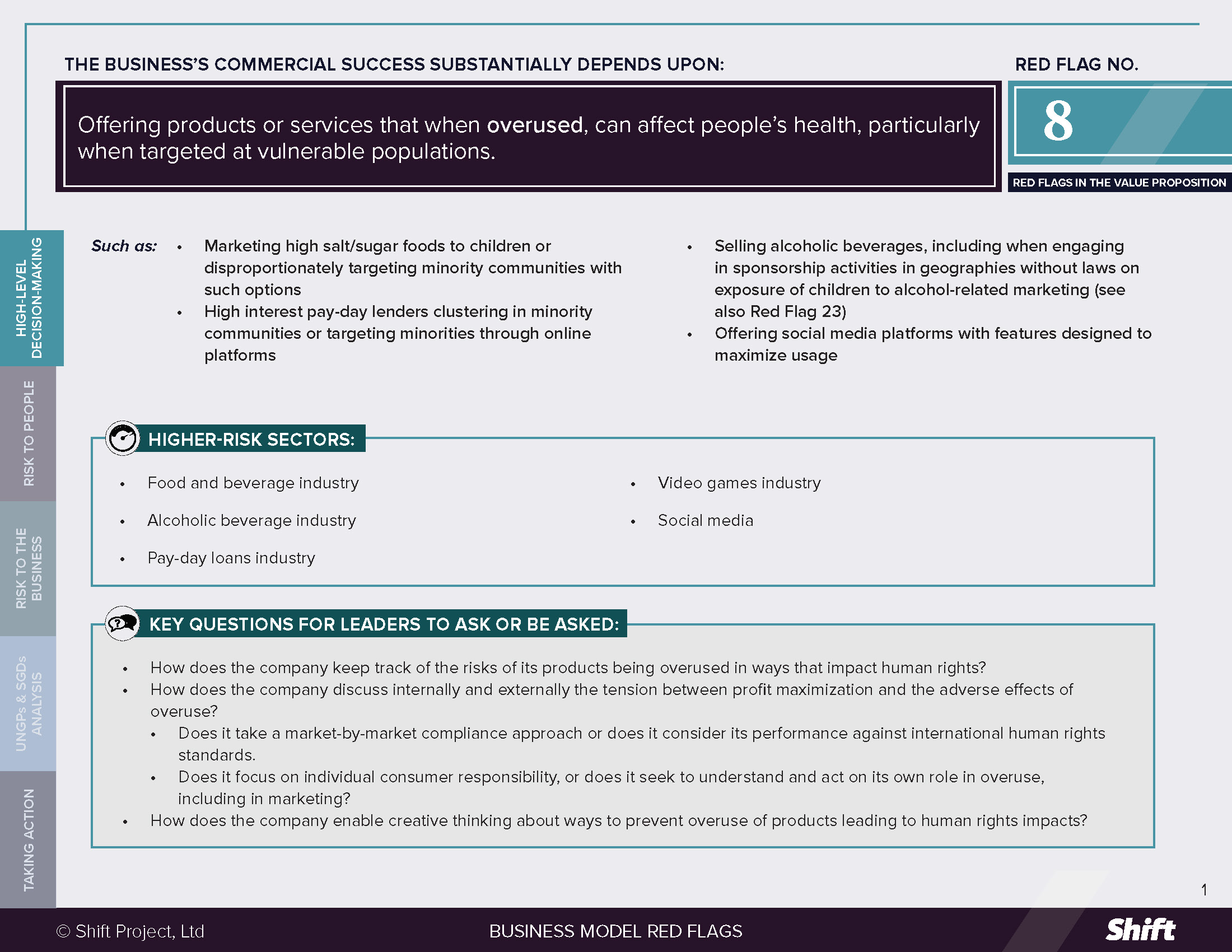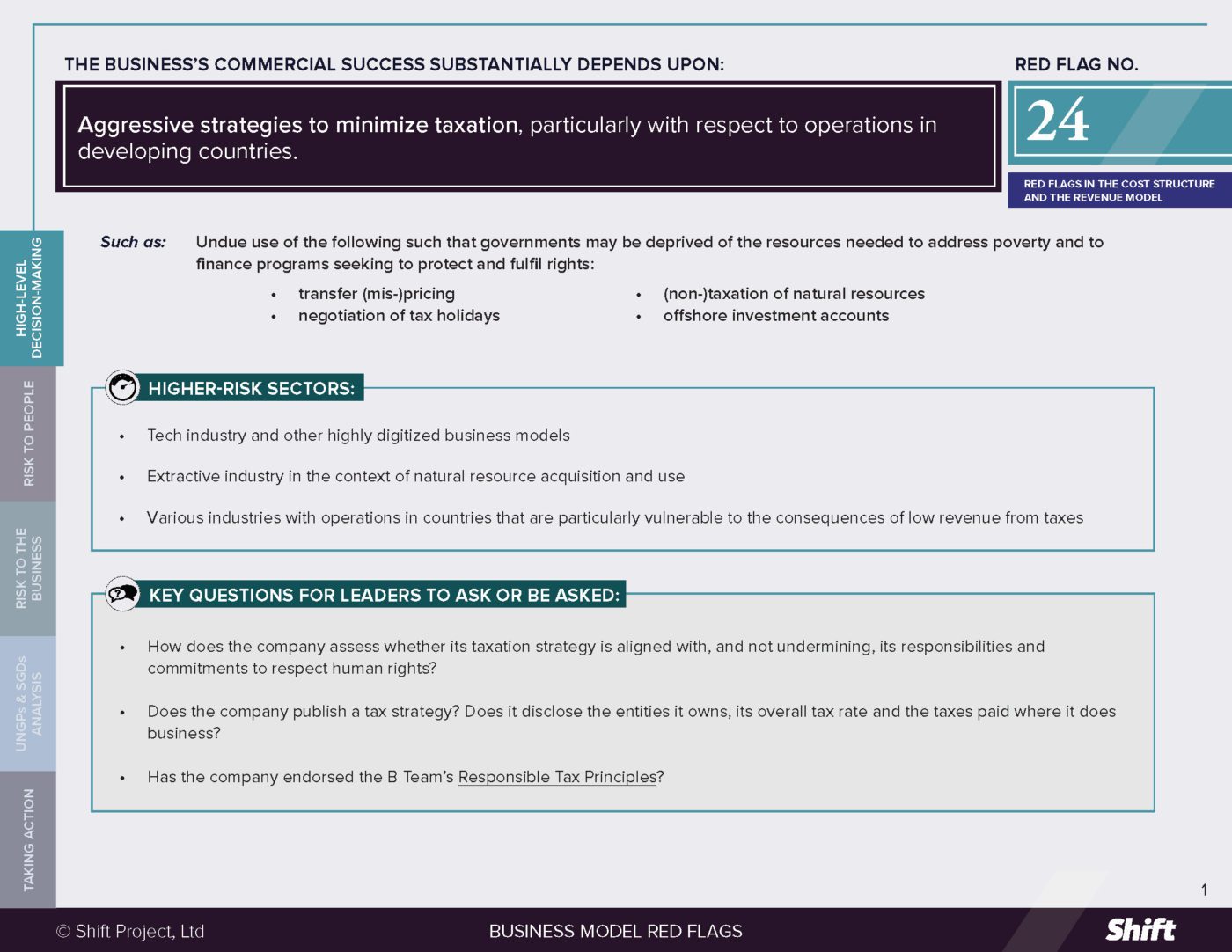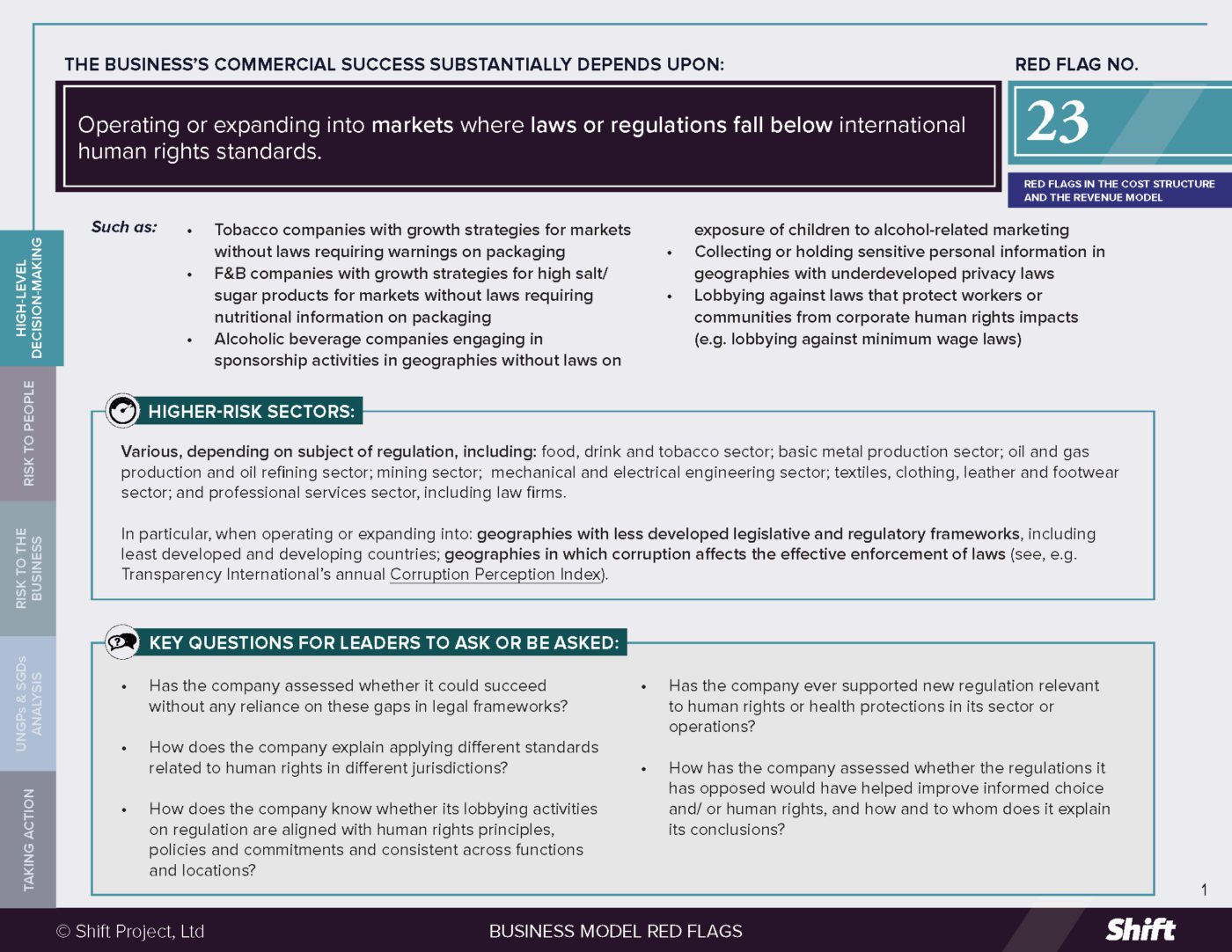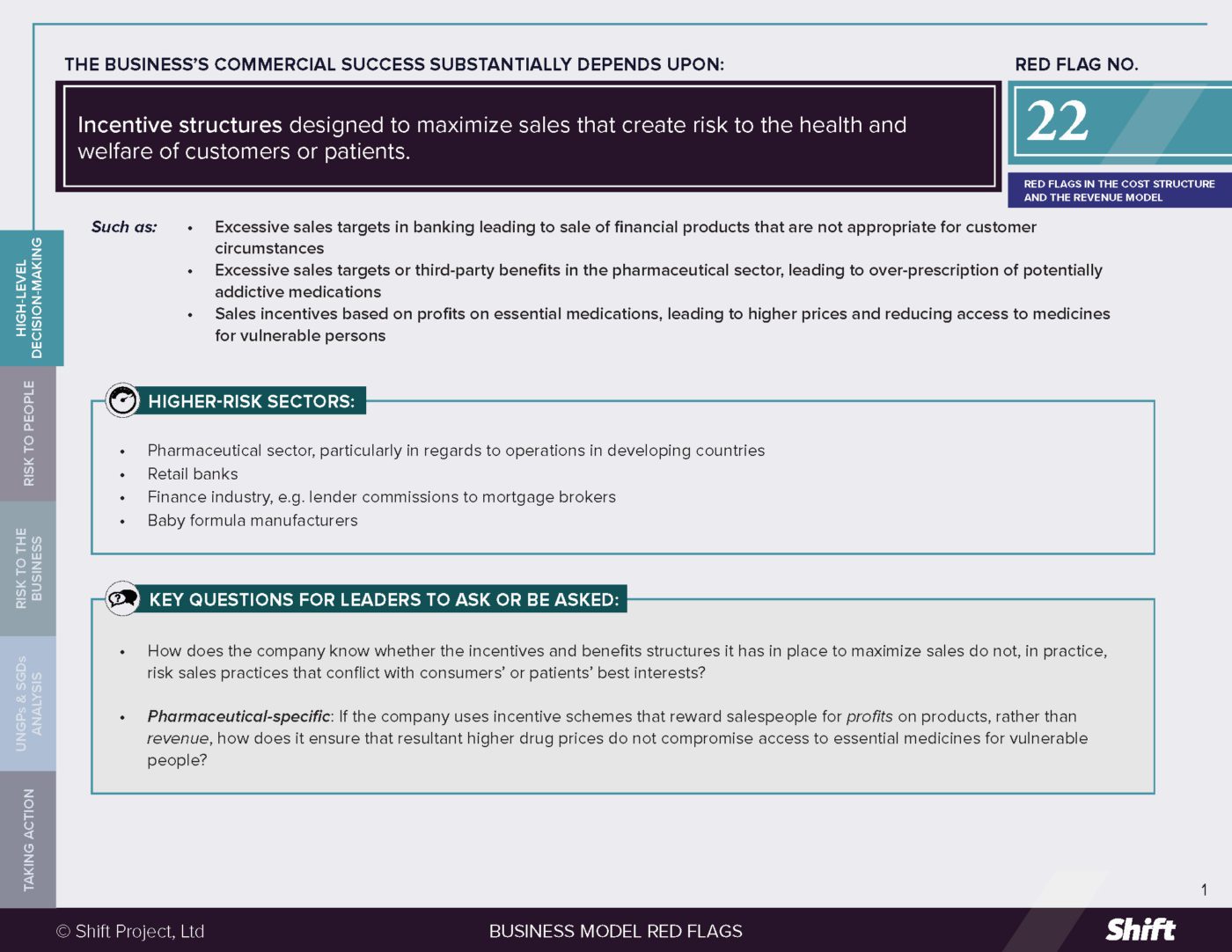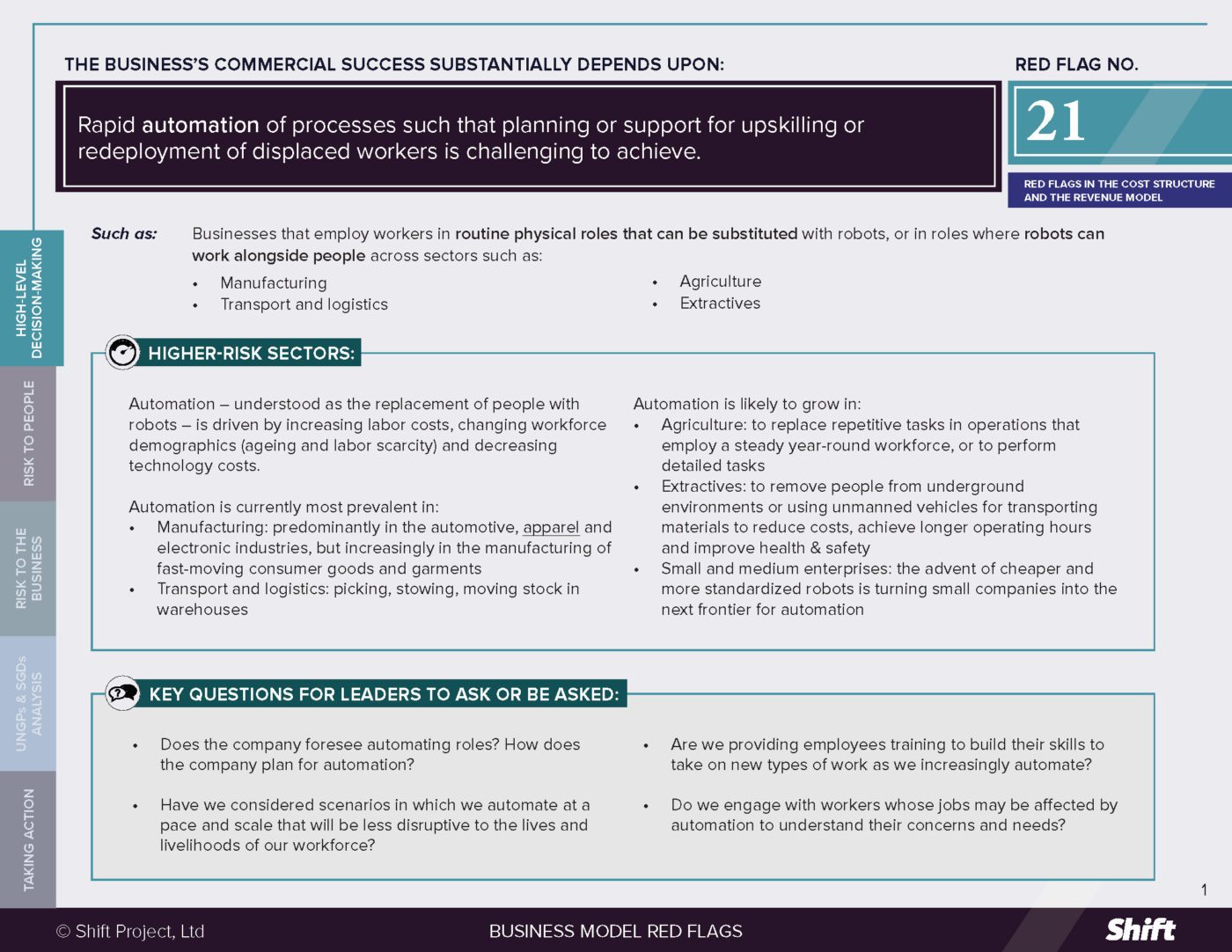RED FLAG # 8
Offering products or services that when overused, can affect people’s health, particularly when targeted at vulnerable populations.
For example
- Marketing high salt/sugar foods to children or disproportionately targeting minority communities with such options
- High interest pay-day lenders clustering in minority communities or targeting minorities through online platforms
- Selling alcoholic beverages, including when engaging in sponsorship activities in geographies without laws on exposure of children to alcohol-related marketing (see also Red Flag 23)
- Offering social media platforms with features designed to maximize usage
Higher-Risk Sectors
- Food and beverage industry
- Alcoholic beverage industry
- Pay-day loans industry
- Video games industry
- Social media
Questions for leaders
- How does the company keep track of the risks of its products being overused in ways that impact human rights?
- How does the company discuss internally and externally the tension between profit maximization and the adverse effects of overuse?
- Does it take a market-by-market compliance approach or does it consider its performance against international human rights standards.
- Does it focus on individual consumer responsibility, or does it seek to understand and act on its own role in overuse, including in marketing?
- How does the company enable creative thinking about ways to prevent overuse of products leading to human rights impacts?
How to use this resource. ( Click on the “+” sign to expand each section. You can use the side menu to return to the full list of red flags, download this Red Flag as a PDF or share this resource. )
Understanding Risks and Opportunities
Risks to People
- Several examples of the impact of overuse on people are listed below. The first three have the potential to impact the right to the highest attainable standard of health and further, where overuse intersects with certain vulnerable groups (children’s rights, or rights of minorities).
- High-salt, High-sugar, High-fat Foods: High levels of consumption are associated with increased health risks, including obesity and other noncommunicable diseases, diet-related diseases in minority communities and rising costs of healthcare where those costs are passed on through higher premiums. Corporate activities that bring about an intersection of vulnerability and potential harm include:
- Marketing to children, including online (esp. via social media) and SMS campaigning to school children at lunch time
- Disproportionate targeting of minorities of low average income, including through selective advertising in specific language media and/or billboards in minority communities. The University of Connecticut Rudd Centre for Food Policy and Obesity has conducted a brand by brand analysis of targeting of black and Hispanic youth by major food and beverage companies in the United States and found that, “food-related marketing continues to disproportionately target youth of color with harmful products and contributes to health disparities affecting their communities.” They found that this was the case even where companies offer diverse portfolios of healthy and unhealthy brands in multiple categories.
- Social Media and Young People: In the UK, a parliamentary committee released a report on the Impact of Social Media on Young People’s Mental Health and Wellbeing. After noting the range of positive effects of social media, it also highlighted “very damaging” effects, including, “feelings of low self-esteem and negative body-image, resulting in harmful behaviours to achieve, ‘results’… the publicising of self-harm methods…[and] cyberbullying” and called for further research into the potentially “‘addictive’ nature of social media.”
- Alcohol: Overconsumption of alcohol can lead to well- documented health impacts in the short and long term. Moreover the US CDC notes that binge drinking is linked to, for example, “motor vehicle crashes” as well as “violence, including homicide, suicide, sexual assault, and intimate partner violence.” Any consumption by children is not recommended due to health impacts. The exposure of children to alcoholic beverage industry marketing is one key challenge.
- High-interest Pay-day Loans: When loan repayments balloon in size and they have difficulty keeping up, recipients may be forced to choose between loans and basic needs, affecting their right to an adequate standard of living (see Human Rights Watch article). There can be a disproportionate effect on minority communities when lenders cluster in those areas, or target minorities through online platforms. Corporate activities that bring about an intersection of vulnerability and potential harm include:
- Targeting potentially vulnerable individuals who are unlikely to meet repayment obligations.
- Offering fin-tech services charging fees for access to advances, which, if regarded as interest, would equate to annualized interest payments many times higher than legal limits (See Nikkei Asian Review article).
Understanding how newer or less-studied products/services may have the potential to be connected to excessive, and even addictive, consumption is an evolving question.
Risks to the Business
- Reputational Risk: Where companies target vulnerable groups in the marketing of products that are harmful when overused, reputational risk may arise. The University of Connecticut report cited above warned that while companies may “view advertising of nutritionally poor brands to multicultural consumers as a business opportunity,” the public may rightly focus on the resulting costs to these communities. Researchers and consumer groups have expressly compared such practices with companies’ public commitments to health, and apparent contradictions are noted and publicized. Moreover, increasingly sophisticated consumers and watch-dog NGOs:
- Identify and publicly call-out companies seeking to focus blame for overconsumption on individuals, without acknowledging the impact of marketing practices.
- Scrutinize non-profit or research bodies set up by industry members for evidence of intent to avoid responsibility for impacts associated with their products.
- Legal and Regulatory Risk: As consumers and international bodies increasingly scrutinize companies selling products or services linked to impacts from overuse, lack of meaningful industry action increases the likelihood of further regulation in this area. For example, six [US] localities had enacted a “soda tax” in 2019, levying a per volume excise tax on drinks sweetened with sugar, and one government levied a per volume tax on all sweetened drinks. As scrutiny leads to consumers seeking to hold companies responsible for impacts, legal risks arise: one US-based pay-day loan company, for example, ceased operations to deal with legal challenges.
- Financial Risks: Understanding of health impacts associated with overconsumption of products has been associated with decreased sales among certain demographics. However, at the same time, the link between overconsumption and profit remains in several industries. For example, a 2018 UK study concluded that the alcohol industry appears to be highly financially dependent upon heavy drinking, and might face significant financial losses were consumers to drink within guideline levels.
- Business Opportunity Risk: Business partners may choose to disengage from companies with business models that are seen as carrying too high a risk from a human perspective. In August 2019, Google banned high-interest lenders from its Google Play app store.
What the UN guiding principles say
*For an explanation of how companies can be involved in human rights impacts, and their related responsibilities, see here.
In certain circumstances, service or product overuse may involve a situation of contributing to harm. For example, this may arise where there are foreseeable inherent risks in the service or product provided (e.g. it is potentially addictive) without appropriate mitigation. Contribution may also be relevant where the product or service is marketed in ways that disproportionately target vulnerable people (e.g. with advertising for nutritionally poor food and beverages, discussed “Risks to People” above.)
In the case of high-interest pay-day loans, where such loans target customers who the company knows, or would know with reasonable investigation, are unable to repay the loan, the company may cause an impact.
Possible Contributions to the SDGs
Addressing impacts to people associated with this red flag indicator can contribute to a range of SDGs depending on the impact concerned, for example:
SDG 3: Good Health and Well-Being, in particular, Target 3.4: By 2030, reduce by one third premature mortality from non-communicable diseases through prevention and treatment and promote mental health and well-being, and Target 3.5: Strengthen the prevention and treatment of substance abuse, including narcotic drug abuse and harmful use of alcohol.
SDG 10: Reduced Inequalities, in particular Target 10.2: By 2030, empower and promote the social, economic and political inclusion of all, irrespective of age, sex, disability, race, ethnicity, origin, religion or economic or other status.
SDG 12: Responsible Consumption and Production, in particular Target 12.8: By 2030, ensure that people everywhere have the relevant information and awareness for sustainable development and lifestyles in harmony with nature.
Taking Action
Due Diligence Lines of Inquiry
- What systems do we have in place to identify and address the potential risk of product overuse?
- How do we know which of our end users/customers are highest risk from a product overuse perspective? How does our marketing strategy intersect with these vulnerabilities?
On Food Marketing:
- How does the nutritional quality of the products we advertise correlate with the age/ethnicity breakdown of our target consumers?
- What percentage of our advertising expenditure is to media viewed predominantly by children? By minority communities?
- Do we disproportionally target food of poor nutritional quality to particular groups?
- Do we take a compliance approach to national labelling laws, or do we always conform to the highest international standards, including relevant human rights? Have we investigated whether there are gaps between voluntary industry self-regulatory programs and international standards?
On Pay-day Loans:
- Would our “fees” be considered exorbitant or illegal if annualized as interest rates?
- Are we operating in a legal grey zone? If so, are we comfortable that we are not profiting from such opportunities to the potential detriment of our customers’ rights?
- What processes do we have in place to ensure that recipients of loans are able to meet repayment obligations?
- Are we confident that our decisions on customer targeting/ shop front locations do not exacerbate or exploit existing vulnerabilities?
- Are we carefully weighing the benefits of making credit more readily available (including through smartphone technology) with the potential negative impacts of greater availability on vulnerable consumers?
Mitigation Examples
* Mitigation examples are current or historical examples for reference, but do not offer insight into their relative maturity or effectiveness.
- Alcoholic Beverages: Leading global beer, wine and spirits producers formed the Alliance for Responsible Drinking (IARD), a not- for-profit organization “dedicated to reducing harmful drinking and promoting understanding of responsible drinking.”
- Social Media: Instagram introduced features in certain countries that hide the number of likes on posts from followers. The decision to “cut off its most addictive feature” was applauded by many as having the potential for “huge [positive] consequences for teens’ mental health.” Instagram also introduced the “You’re All Caught Up” message in Feed to prevent passive and mindless scrolling of already-viewed content.
Alternative Models
- Alcoholic Beverages: With motivations ranging from the ethical, personal health, to purely commercial (noting that the number of people who consume alcohol in the world has decreased by nearly 5 percent since 2000), several brands and start-ups have begun offering non-alcoholic alternatives: Diageo (the world’s second largest distiller and parent of Guinness, Smirnoff and Johnnie Walker) recently funded a nonalcoholic spirits company called Seedlip.
Other Tools and Resources
- Food Marketing: University of Connecticut Rudd Centre for Food Policy and Obesity has several reports including a brand by brand analysis of targeting of black and Hispanic youth by major food and beverage companies in the United States. See also WHO (2019) Reducing the impact of marketing of foods and non-alcoholic beverages on children.
- Social Media: UK parliamentary committee report on the Impact of Social Media on Young People’s Mental Health and Wellbeing.

 Business Model Red Flags
Business Model Red Flags  Tool for Indicator Design
Tool for Indicator Design 